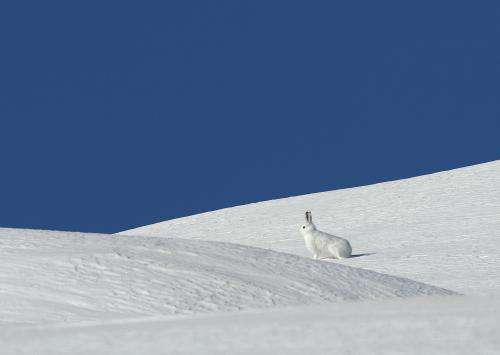Mountain hares are esealy stressed by winter tourists and therefore need undisturbed places to eat and rest. Credit: Rolf Giger
The mountain hare is rarely seen in the wild. It lives in the higher regions of the Alps and is famous for its beautiful white winter coat. Now, however, climate change and winter tourism are threatening the mountain hare's natural habitat. Researchers at the University of Veterinary Medicine Vienna (Vetmeduni Vienna) have confirmed for the first time that mountain hares suffer more stress in areas that are visited by large numbers of tourists than their conspecifics in quieter areas. Stressed hares expend more energy, and that can be life-threatening in the cold Alpine winter. The results of this research are published in the prestigious Journal of Applied Ecology.
In the Alps, mountain hares (Lepus timidus) live at altitudes of 1,300 metres and higher, but the mountain hare population in the Alps is now under threat for various reasons. One cause is climate change. Rising temperatures are forcing the hares to migrate to higher altitudes. At the same time, the expanding winter tourism industry is an additional stress factor for these animals, although their physiological and behavioural response to tourist activity had not previously been studied.
Biochemist and stress analyst Rupert Palme, from the Institute of Medical Biochemistry at the Vetmeduni Vienna, teamed up with the Swiss Wildlife biologist Maik Rehnus to examine the stress levels of Alpine mountain hares in the Swiss National Park in Graubünden and in neighbouring skiing resorts.
Stress can be detected in the hares' faeces
Maik Rehnus, a mountain hare expert, went for a long mountain hike in search of Bölleli – the Swiss German word for hare faeces. In the winter of 2011, he collected 132 faecal samples while hiking a total distance of 43 kilometres through areas that had no, medium or high levels of tourist activity. The researchers then measured the levels of faecal glucocorticoid metabolites (GCM) in the samples in order to determine the stress levels of the animals. Biochemist Palme analysed the samples and concluded: "Faecal samples that were found in areas with high tourist traffic indicated higher stress levels than samples found in areas further from tourists. It made no difference whether the winter tourists were skiers, cross-country skiers or hikers using snowshoes."
Stress alters behaviour and food intake
To double-check their findings and investigate the behaviour of mountain hares further, the researchers conducted controlled trials with six mountain hares in captivity. These hares were exposed to stress stimuli, such as a dog and a paper kite which served to mimic potential enemies. The researchers collected and analysed faecal samples, both after the stressful situations and also after periods of rest. The faecal samples showed increased stress levels after the stressful situations, but the animals also changed their behaviour. Under stress, the mountain hares rested less and spent less time grooming. What is more, the stressed hares were less likely to consume their own faeces, a phenomenon known as coprophagia. Coprophagia is a natural behaviour which allows the animals to maximize the amount of essential nutrients and vitamins that they absorb. Particularly in winter, when food is scarce, this behaviour is a crucial source of extra energy. If coprophagia is disrupted for whatever reason, it means that the hares' intake of nutrients and calories drops during the cold and barren winter, and this can easily become life-threatening.
"We assume that the behaviour and physiology of stressed hares in the wild will be similar. Stress leads to increased energy consumption in the mountain hares. This could threaten the reproduction and survival of hares in winter and also negatively impact their reproduction. We therefore recommend that forests inhabited by mountain hares are kept free of tourism infrastructure, and that areas of undisturbed forest are created in skiing areas. Other endangered species in the Alps could also benefit from these measures", explains Rehnus.
Rupert Palme of the University of Veterinary Medicine Vienna collaborated on this project with the University of Natural Resources and Life Sciences, Vienna, the Swiss Federal Institute for Forest, Snow and Landscape Research and the Landscape and Animal Park Goldau.
More information: onlinelibrary.wiley.com/doi/10 … -2664.12174/abstract
Journal information: Journal of Applied Ecology
Provided by University of Veterinary Medicine -- Vienna




















